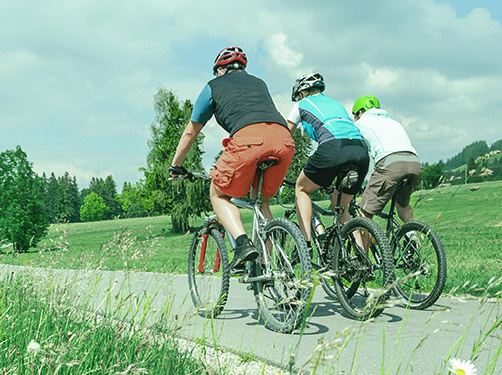What is insulin resistance?
Scientific support: Dr. Theresia Sarabhai
Insulin is an important hormone for metabolism. It is produced by beta cells in the pancreas and then distributed throughout the body via the blood circulatory system. The hormone binds to the body’s cells and sends signals or “instructions”. The focus is on the cells of the muscles, fatty tissue and liver. In people with insulin resistance, the body’s cells react less sensitively to the insulin signals than those in a person with a healthy metabolism. The natural effect of insulin is then limited.

Among other things, insulin helps mediate the absorption of sugar (glucose) from the blood by the body's cells. This means that the hormone plays an essential role in the regulation of blood sugar by reducing blood sugar levels. If the cells are no longer sufficiently sensitive to insulin, i.e., if they are insulin resistant, less sugar is transferred from the blood into the body’s cells. Instead, sugar remains in the blood circulatory system and the blood sugar levels begin to increase. In the long-term, this can result in the onset of type 2 diabetes.
Insulin resistance is often hereditary. However, type 2 diabetes usually develops when an inactive lifestyle with little physical activity is coupled with a poor diet and/or abdominal obesity.
Good to know:
To compensate for the insulin resistance and achieve the same insulin effect as a person with a healthy metabolism, the pancreas increases insulin production. Over the long-term, the insulin-producing beta cells become exhausted and type 2 diabetes develops.
Contents
- How does insulin resistance develop?
- What increases the risk of insulin resistance?
- How does insulin resistance manifest itself and how is it diagnosed?
- What can be done to prevent insulin resistance?
- What are the health risks associated with insulin resistance?
- Why does insulin resistance cause type 2 diabetes?
- How is insulin resistance treated and can it be cured?
1. How does insulin resistance develop?
The mechanisms that result in insulin resistance are not yet fully understood.
The hormone insulin binds to the body’s cell, for example, in the muscles, fatty tissue, or liver, and begins to send signals with instructions. An example is the signal for the cell to begin to absorb sugar (glucose) from the blood circulatory system. The sugar is needed in the cell to generate energy. For example, muscle cells use sugar as an energy source to move the muscles.
Good to know:
In the case of insulin resistance, the cells react only partially or not at all to the insulin signals. The mechanisms that trigger insulin resistance in the body are still being researched.
2. What increases the risk of insulin resistance?
Insulin resistance can be hereditary. The probability of developing insulin resistance is especially high when a first-degree relative (parents or siblings) suffers from type 2 diabetes. However, other lifestyle factors must be present to cause the insulin resistance to progress and type 2 diabetes to develop.
Frequent risk factors that play a significant role in the onset of insulin resistance are:
- Obesity: Fat cells, especially in the abdominal region, release messenger substances that promote insulin resistance. As a rule of thumb: The greater the amount of abdominal fat, the poorer the effect of the hormone insulin.
- Lack of physical activity: Not enough physical activity promotes obesity. In addition, a lack of muscular activity directly leads to a reduction in the effectiveness of insulin.
- Poor diet: Too much unhealthy fat, too many calories, and not enough fiber all promote obesity, insulin resistance, and increased blood sugar levels.
Factors such as stress, certain types of medications, e.g., glucocorticoids and smoking can also negatively affect the insulin sensitivity of the body's cells. However, the influence is less pronounced and, in some cases, only temporary.
Good to know:
Genetically predisposed people are approximately twice as likely to be insulin resistant than those with no relative with type 2 diabetes in their immediate family. However, insulin resistance can also be acquired without genetic predisposition.
3. How does insulin resistance manifest itself and how is it diagnosed?
Insulin resistance itself does not cause any symptoms and therefore remains undiscovered for a long time. The reduced sensitivity to insulin often becomes noticeable when complications have already developed, or elevated blood sugar has been repeatedly diagnosed. Years or even decades can pass before elevated blood sugar levels develop as a result of insulin resistance During this time, those affected often don’t notice any change to their sugar metabolism.
Certain characteristics can indicate insulin resistance. However, their presence doesn't always mean that there is insulin resistance. These characteristics include:
- Elevated Triglycerides values in your blood
- Reduced HDL cholesterol values in your blood
- High blood pressure
- Abdominal obesity (too much stomach fat)
- Elevated blood sugar levels
- Type 2 diabetes in the family (parents or siblings)
The more that these characteristics are present, the more likely insulin resistance is.
A simple process to determine insulin resistance is calculation of the HOMA index (HOMA = homeostasis model assessment). The fasting insulin levels and fasting glucose levels (using the unit mmol/l) are measured and multiplied by one another. When the HOMA index value exceeds a certain level, it can be assumed that insulin resistance is likely. The HOMA index is especially suited to determining the early and middle phases of insulin resistance. When the insulin-producing cells in the pancreas are already exhausted, the HOMA index no longer has any indicative value for insulin resistance.
An elevated level of intact proinsulin in blood also points to insulin resistance. Proinsulin is a precursor of insulin. Proinsulin is normal fully converted into insulin meaning that only minute amounts of proinsulin can be detected in the blood. When the pancreas increases insulin production due to insulin resistance, this can result in proinsulin not being fully converted into insulin and being detectable in higher levels in blood.
Determination of the effects of insulin is very complex and is usually only carried out at specialized diabetes centers - and normally only during studies. The clamp technique is used. Using this technique, a defined amount of insulin and variable amount of glucose is administered directly into a venous blood vessel via a port until a normal blood sugar level has been achieved. The greater the amount of glucose that can be administered together with a fixed amount of insulin, the more effective the insulin and the lower the insulin resistance.
4. What can be done to prevent insulin resistance?
Insulin resistance is promoted by certain lifestyle habits. The good news: Making changes to your lifestyle habits can help improve the insulin resistance of the body’s cell. This helps prevent the onset of insulin resistance or the reduction of preexisting insulin resistance. Effective measures include regular physical activity, weight loss if overweight (especially if there is too much abdominal fat) and a corresponding adjustment of dietary habits.
5. What are the health risks associated with insulin resistance?
Insulin resistance is often accompanied by high blood pressure, fat metabolism disorders, obesity, and elevated blood sugar levels – experts call this a metabolic syndrome.
Insulin resistance is not only a significant cause of type 2 diabetes: the reduced sensitivity of the body’s cells to the hormone insulin can also promote high blood pressure and premature damage to blood vessels. The possible long-term complications include nerve damage, kidney damage, heart attack, and stroke. This makes it all the more important to detect insulin resistance early and take steps to combat it.
6. Why does insulin resistance cause type 2 diabetes?
Insulin resistance is one of the major causes of type 2 diabetes. In most cases, it exists for years or decades before type 2 diabetes is diagnosed.
Insulin resistance is when the reaction of the body’s cells to the signal from the hormone insulin is reduced. This results in the pancreas increasing insulin production. The reduced effect of insulin can then be counterbalanced for a time. However, the body then requires ever-increasing amounts of insulin to achieve an effect comparable to that of people with a healthy metabolism. At a certain point, the pancreas will reach the limit of its capacity and will no longer be able to produce enough insulin.
When the effect of insulin is reduced or less insulin is being produced by the pancreas, this is known as a relative insulin deficiency. For example, this results in less of sugar (e.g., from food) entering the cells to act as an energy source. Instead, the sugar (glucose) remains in the blood and the blood sugar level increases. Initially, blood sugar levels are only elevated after consuming food, but later this becomes a permanent state: This is type 2 diabetes.
7. How is insulin resistance treated and can it be cured?
Insulin resistance can be effectively influenced by implementing the corresponding changes to lifestyle habits. Regular physical activity, weight loss, if overweight (especially if there is too much abdominal fat) and tailored nutritional counseling can help reduce the severity of insulin resistance and prevent type 2 diabetes.
Good to know:
Skeletal muscles are responsible for more than 80 percent of sugar absorption from the blood. Regular physical exercise improves the insulin sensitivity of the cells. This allows more sugar (glucose) to be absorbed from the blood circulation by the muscle cells, resulting in a fall in blood sugar levels.
Sources:
Adeva-Andany, M. M. et al.: Insulin resistance is a cardiovascular risk factor in humans. In: Diabetes Metab Syndr, 2019, 13: 1449-1455
American Diabetes Association: Understanding Insulin Resistance (Letzter Abruf: 02.03.2022)
da Silva Rosa, S. C. et al.: Mechanisms of muscle insulin resistance and the cross-talk with liver and adipose tissue. In: Physiol Rep, 2020, 8: e14607
Internationale Diabetes Föderation: IDF consensus worldwide definition of the metabolic syndrome. 2006 (Letzter Abruf: 02.03.2022)
James, D. E. et al.: The aetiology and molecular landscape of insulin resistance. In: Nat Rev Mol Cell Biol, 2021, 22: 751-771
Kahn, S. E. et al.: Mechanisms linking obesity to insulin resistance and type 2 diabetes. In: Nature, 2006, 444: 840-846
Malin, S. K. et al.: Fasting hyperglycaemia blunts the reversal of impaired glucose tolerance after exercise training in obese older adults. In: Diabetes Obes Metab, 2012, 14: 835-841
Mastrototaro, L. et al.: Insulin resistance and insulin sensitizing agents. In: Metabolism, 2021, 125: 154892
Matthews, D. R. et al.: Homeostasis Model Assessment: Insulin resistance and β cell function from fasting plasma glucose and insulin concentrations in man. In: Diabetologia, 1985, 28: 412-419
Park, S. Y. et al.: Assessment of Insulin Secretion and Insulin Resistance in Human. In: Diabetes Metab J, 2021, 45: 641-654
Petersen, M. C. et al.: Mechanisms of Insulin Action and Insulin Resistance. In: Physiol Rev, 2018, 98: 2133-2223
Stern, S. E. et al.: Identification of Individuals With Insulin Resistance Using Routine Clinical Measurements. In: Diabetes, 2005, 54: 333-339
Whillier, S.: Exercise and Insulin Resistance. In: Adv Exp Med Biol, 2020, 1228: 137-150
As of: 02.03.2022




